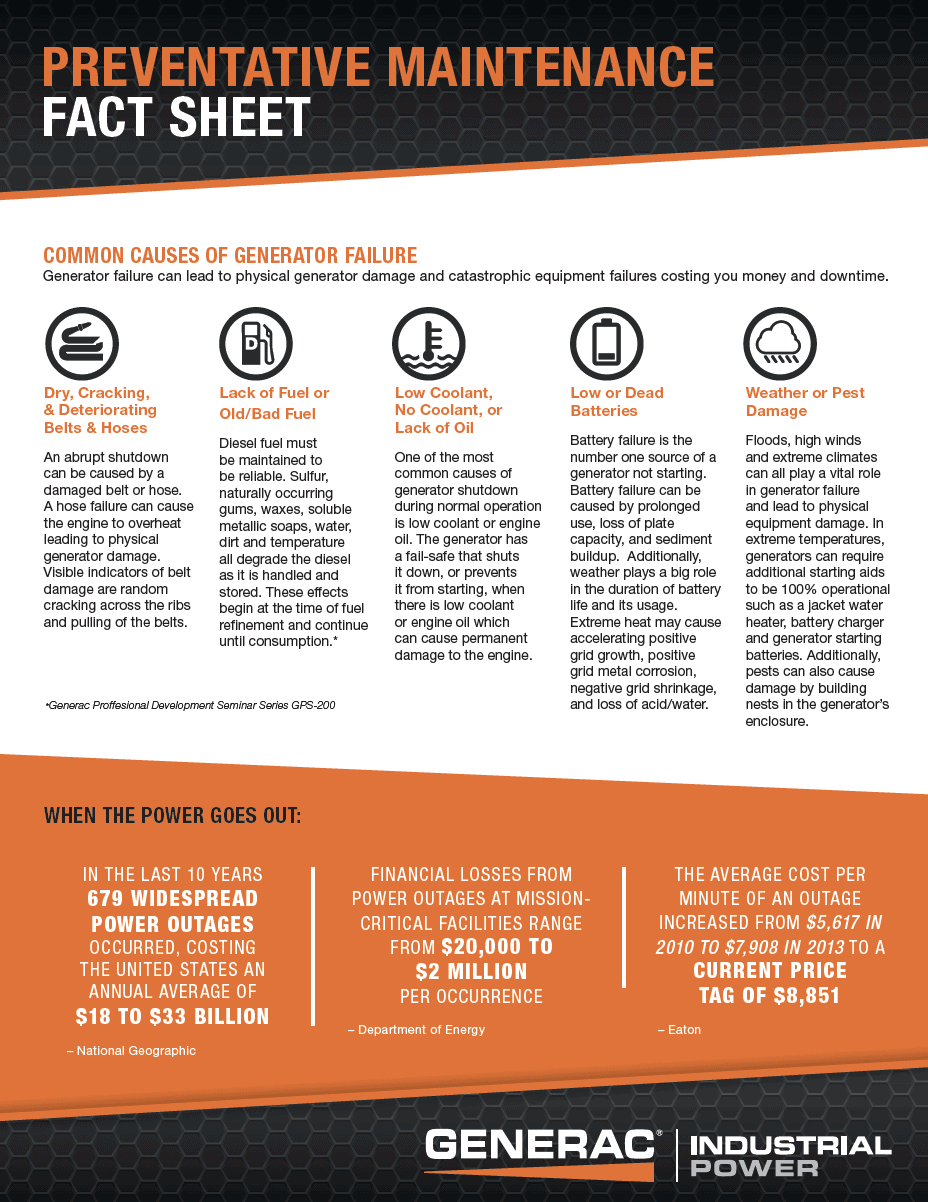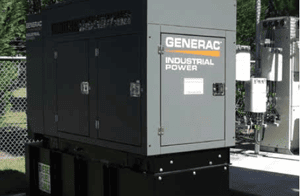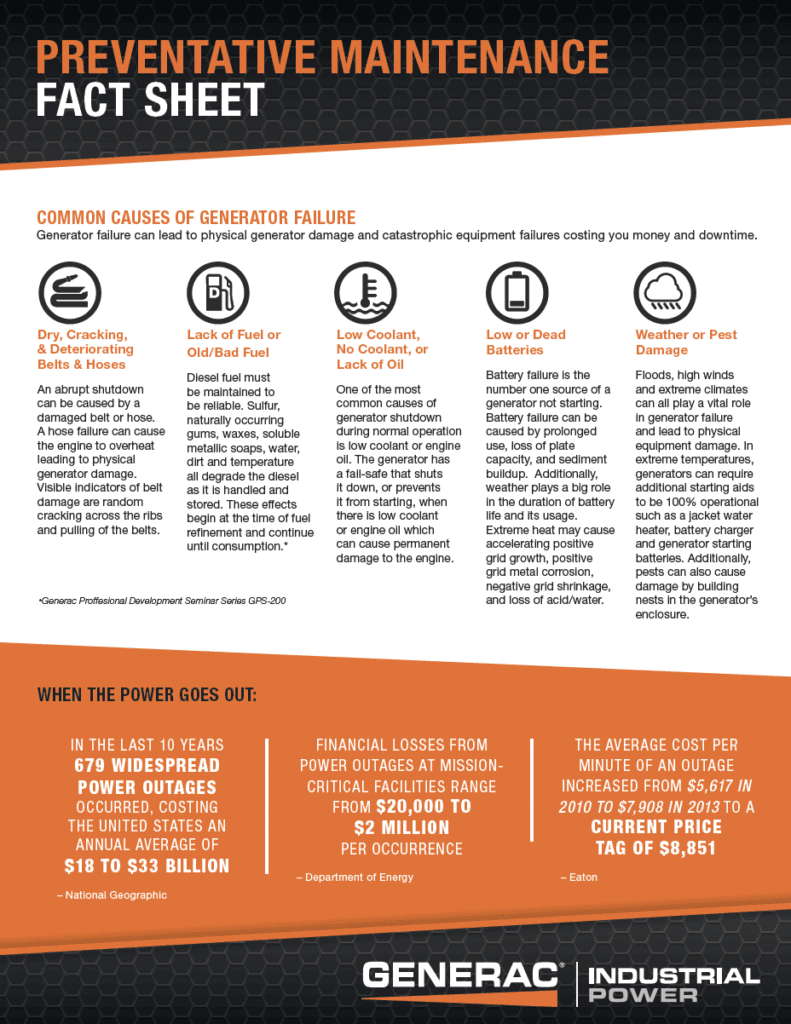January 2020 Articles:
Generator Preventative Maintenance Fact Sheet
 The primary cause of generator failure is lack of maintenance. Neglecting generator maintenance can lead to physical generator damage and catastrophic equipment failures costing you money and downtime. Learn about the 5 main causes of generator failure by downloading Generac’s common causes of generator failure fact sheet.
The primary cause of generator failure is lack of maintenance. Neglecting generator maintenance can lead to physical generator damage and catastrophic equipment failures costing you money and downtime. Learn about the 5 main causes of generator failure by downloading Generac’s common causes of generator failure fact sheet.
- Dry, cracking and deteriorating belts and hoses
- Lack of fuel or old/bad fuel
- Low coolant, no coolant or lack of oil
- Low or dead batteries
- Weather or pest damage
Diesel Fuel Management
BY BRIAN BOEZI, President/CEO, B3C and GREG ALLEN, Vice President, B3C
INTRODUCTION
Today’s diesel fuel contains many types of contaminants; all of them harmful to fuel or engine systems. For this reason, it is critical to have a fuel maintenance plan. Most of us are familiar with common petroleum diesel fuel, but we may not be as familiar with current biodiesel and low sulfur diesel. Biodiesel is a clean burning alternative fuel produced from vegetable oils or animal fats (lipids). It is often blended with petroleum diesel to create biodiesel blends with 5 to 20% bio-content common in the United States (i.e. B20 = 20% bio and 80% diesel).
This modern diesel fuel comes with a host of issues that affect your engines and therefore the operation of your equipment. This includes biodegradability, solvent capabilities, and its ability to corrode or harm fuel system components. It can also contain up to ten times (10X) more water than common petroleum diesel fuel.
ULTRA-LOW SULFUR DIESEL

ENVIRONMENTAL PROTECTION AGENCY REGULATIONS
According to the EPA, the reduction of sulfur content in diesel fuel will reduce or eliminate:
- 2.6 million tons of smog-causing nitrogen oxide emissions each year
- 110,000 tons of soot or particulate matter per year
- An estimated 8,300 premature deaths, 5,500 cases of chronic bronchitis and 17,600 cases of acute bronchitis in children annually
- An estimated 360,000 asthma attacks and 386,000 cases of respiratory symptoms in asthmatic children every year
- 1.5 million lost work days, 7,100 hospital visits and 2,400 emergency room visits for asthma
Under the EPA regulations, the cleaner diesel fuel program significantly reduces sulfur content, creating immediate health benefits, and allowing engine manufacturers to begin using advanced emissions control systems that further reduce harmful emissions. ULSD has been required for non-road, locomotive and marine engines since 2014. These fuel requirements, coupled with advanced emission control technologies, will decrease emissions from these engines by more than 90%.
CONTAMINANTS WITHIN THE TANK
Diesel fuel and biodiesel inherently contain water. In fact, the very specification of diesel fuel causes concern. According to ASTM D-975, diesel fuel:
- Can contain up to 5% biodiesel and be labeled ULSD #2
- Can contain up to 500 parts per million (ppm) of water and sediment
- Has no minimum requirement for detergent or dispersant
According to Fuel Marketer News, at 500 PPM, every tanker load of delivered diesel fuel may contain up to 5 to 7 gallons of water. Water is the greatest enemy to fuel and engine systems and no amount of water in your diesel fuel or equipment is acceptable. In addition to being inherent in diesel and biodiesel, water is caused by such things as condensation from temperature fluctuations and high humidity, external leaks in tanks and biodiesel blends.
As an example, biofuels are hygroscopic, absorbing water from the atmosphere. Water will separate out of the fuel, sit on the bottom of a fuel tank and provide a breeding ground for microbial growth. In fact, organic compounds make up about 90% of the contaminants found in fuel. A vicious cycle begins in which the microbial growth releases more harmful contaminants into the fuel and atmosphere within the tank. The proliferation of detrimental contaminants continues, including rust and sediment, biofilms, asphaltenes, gums and sludge.
DIESEL CONTAMINATION
Understanding the different forms of contamination is helpful in determining how to avoid or eliminate these problems:
Water – Water is perhaps the largest issue when it comes to contaminates as it can be found in various states; dissolved, emulsified and free states.
Diesel bug – Diesel bug is a generic term for the microbial growth within a fuel tank or system and can be made up of 100 different types of bacteria, molds and yeasts.
Biofilms – A complex structure adhering to surfaces that are regularly in contact with water, consisting of colonies of bacteria and usually other microorganisms such as yeasts, fungi, and protozoa that secrete a mucilaginous protective coating in which they are encased. Biofilms can form on solid or liquid surfaces.
Asphaltenes – Are solid particles in crude oil/diesel fuels, hard, brittle particles that are not soluble in fuel. They vary in size from 2 microns on up. Since the EPA has mandated the use of ULSD, asphaltenes in diesel fuels are becoming a much larger problem. Asphaltenes are small organic material that resembles asphalt. The higher sulfur content diesel fuels helped keep the asphaltenes in check. Unfortunately, the ULSD does not.
Gums and other organic contaminants – The oxidation stability of biodiesel is inferior to that of diesel. Meaning that, as the fuel comes into contact with oxygen, chemical reactions break down the fuel into peroxide, organic acids and gummy sediment. These soft, sticky substances can stick to fuel filters and engine components and cause acid erosion.
Wax – The way fuel has been changed, directly affects how the additives work. Old additives do not work with the new fuel. Thus, wax crystals are formed.
Other particles – Other particles can be present in fuel with diverse sources such as road dust and grit, soot, fuel tank rust and engine wear particles. All particles, regardless of source have the potential to cause wear or damage to the fuel injection system or engine
Sludge – Sludge is likely formed from a combination of many of the above contaminants.
Given the inherent issues with fuel, like water, and negative forces of contamination, combined, working against diesel fuel, all of these issues are compounded. It is easy to see how fuel quickly becomes and stays contaminated.
WHAT CAN YOU DO?
A healthy fuel system is free of water, particulate matter, and microbial contamination and requires a proactive plan of action to eliminate and prevent fuel contamination. Generac is pleased to offer the following regimen for monitoring and maintaining your diesel fuel in order to ensure a healthy fuel system. A healthy fuel system will lead to proper operation while helping you avoid downtime and costly repairs or procedures.
A suggested regimen and options include:
Treat and Stabilize the Fuel:
- Use Generac All-In-One Diesel Additive that is engineered for use in generator and storage applications. Add and maintain Generac Diesel Fuel Additive (A0000018975) in the unit at initial and every fill up – use at a ratio of 1 oz. additive per 10 gallons of fuel.
- Familiar “shelf additives” are not typically effective for long-term storage. Treat the fuel in the fuel tank with an additive / stabilizer that will protect the entire diesel fuel system from corrosion and oxidation, and stabilizes the fuel as it ages.
Generac All-In-One Diesel Additive will protect the fuel system and extend the life of the tank and engine components.
a. Cleans injectors and pumps
b. Replaces lost lubrication
c. Disperses water and removes sludge
d. Stabilizes the fuel
e. Biodiesel protection
f. Helps avoid costly procedures like fuel polishing
Control the Water on an Ongoing Basis:
- Install a Generac Diesel Tank Water-Absorbing Device. Keep a diesel tank water absorber in your equipment or bulk tank at all times for continuous water removal and prevention of sludge, bacteria, algae.
a. Protects the diesel fuel tank by continuously removing water to prevent sludge,
bacteria, and fungus
b. High strength neodymium magnets remove rust and metal particles
c. Easy to install and remove by high strength tether line
- Add a 3-foot reusable Generac Diesel Fuel Tank Water Absorber (A0000018988) to the fuel tank for protection in storage.
a. Check every 3-6 months for water.
b. Replace annually, or sooner if full of water. It is recommended to have two per
unit (one in use, one drying out). Reuse up to 10 times.
- Use the Generac Fuel Life Tank Snake (A0000019000) for top
ADDITIONAL OPPORTUNITIES:
Test the Fuel Annually:
- Lab Testing: Leverage a third-party resource. Example tests include:
a. ISO 4406 Particle Count
b. ASTM D4739 Base Number (BN)
c. ASTM D4377 Karl Fischer Water Determination
d. ASTM D664 Acid Number (AN)
- Quick Test: An example quick test option is a diesel 4 in 1 Test Swab that identifies fuel quality, water, and contamination including rust, sludge, and asphaltenes.
Eliminate Contamination if Present:
- Fuel Polishing: Fuel Polishing is a mechanical process (advanced level filtration via a central processing unit) to clean out water, sludge, asphaltenes, and other non-fuel contamination to return the fuel back to original condition so it is usable again. Quality fuel polishing can help remove the water and solid contamination in the tank (e.g. sludge and asphaltenes), however, it has limited capabilities in removing the actual microbial infestation (which may allow the sludge to come back). For microbial contamination, a biocide is recommended.
- Biocide: If microbial contamination is present, treat the fuel with a Diesel Fuel Biocide. When using biocide, you will need to separate or remove the dead particles from the fuel. Once a preventive plan is put in place, biocide is not necessary on an ongoing basis.
CONCLUSION
It is critical to understand what is happening in the fuel tank by becoming a “fuel expert”. By thoroughly understanding the mechanics of today’s modern diesel fuel, and how it affects fuel tanks and equipment, you can avoid damaging your equipment and make sure your generator system works properly when you need it the most.


